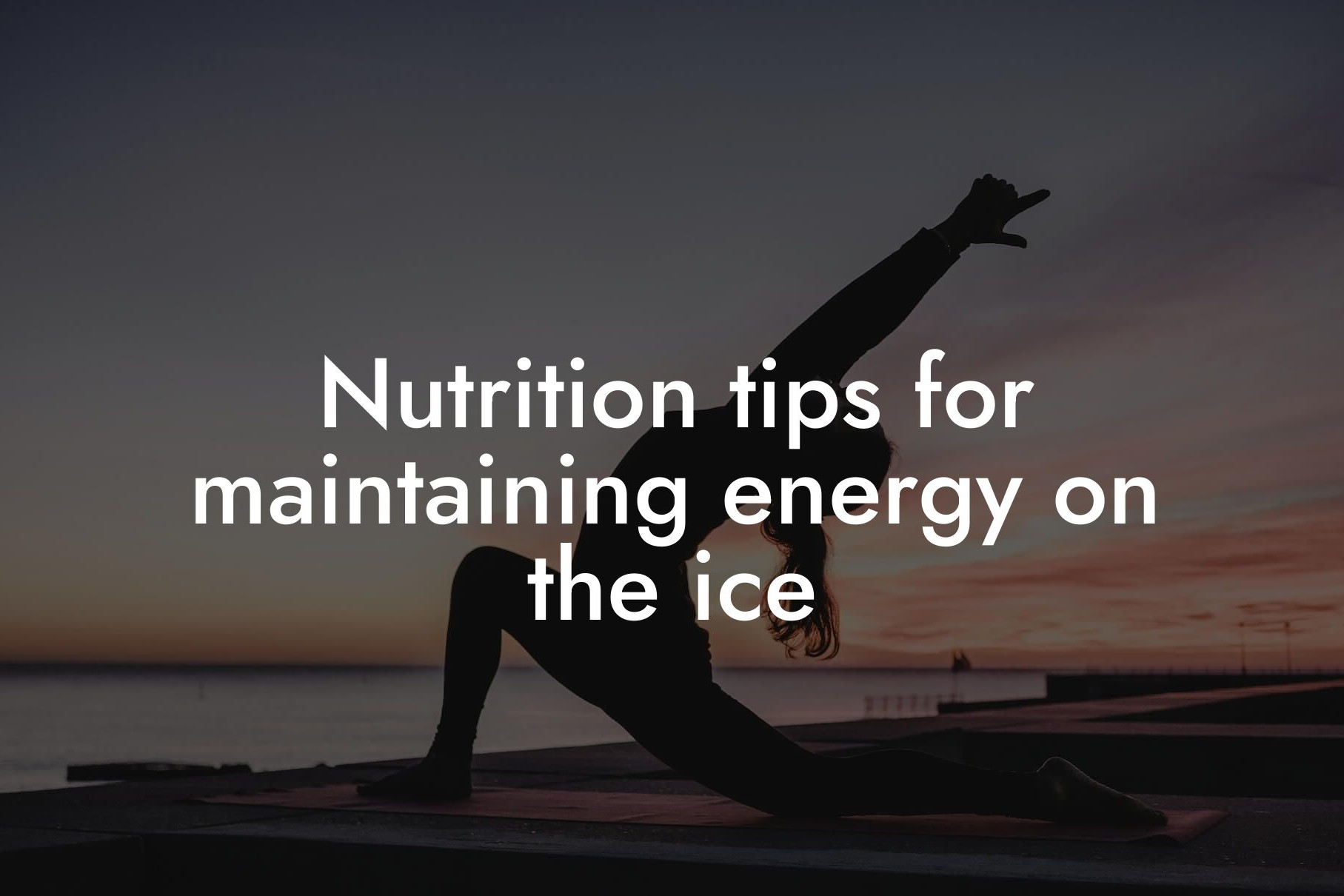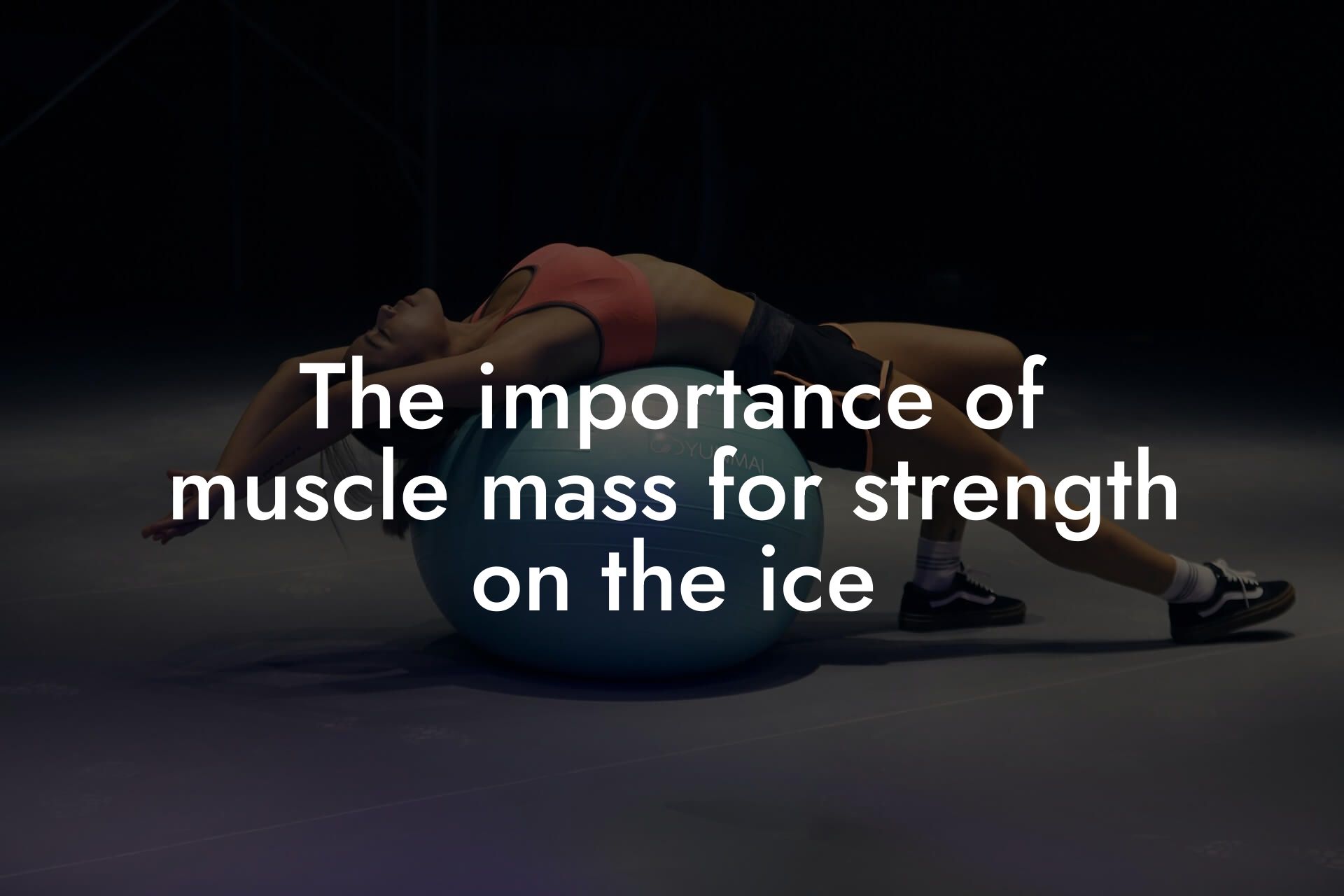Introduction
As a high-earning professional, you understand the importance of maintaining a healthy and athletic physique. For hockey players, having the right body composition is crucial for optimal performance on the ice. Body composition refers to the percentage of fat mass and lean mass in the body. A well-balanced body composition can improve speed, agility, strength, and endurance, giving hockey players a competitive edge. In this article, we will explore how body composition affects hockey performance and why it's essential for players to monitor and optimize their body composition.
Table of Contents
- Introduction
- The Importance of Lean Mass in Hockey
- The Impact of Body Fat on Hockey Performance
- The Ideal Body Composition for Hockey Players
- How DEXA Scans Can Help Hockey Players
- The Role of Nutrition in Body Composition for Hockey Players
- Training Strategies for Optimizing Body Composition
- Frequently Asked Questions
The Importance of Lean Mass in Hockey
Lean mass, which includes muscle mass, bone density, and water, is essential for generating power, speed, and endurance in hockey. A higher percentage of lean mass enables players to accelerate faster, maintain speed, and withstand the physical demands of the game. Additionally, lean mass helps to improve bone density, reducing the risk of injuries and fractures. In hockey, having a high percentage of lean mass is critical for success, as it allows players to maintain a high level of intensity over an extended period.
The Impact of Body Fat on Hockey Performance
Excess body fat can hinder a hockey player's performance in several ways. Firstly, it increases the energy expenditure required to move around the ice, reducing speed and endurance. Secondly, excess body fat can lead to decreased power output, making it more challenging to accelerate and decelerate. Finally, excess body fat can increase the risk of injuries, particularly in the knees, hips, and lower back. For hockey players, maintaining a low percentage of body fat is crucial for optimal performance.
The Ideal Body Composition for Hockey Players
Research suggests that the ideal body composition for hockey players is a lean mass percentage of 70-80% and a body fat percentage of 10-15%. This range allows for optimal power output, speed, and endurance while minimizing the risk of injuries. However, it's essential to note that body composition requirements can vary depending on the position played. For example, goalies may require a slightly higher percentage of body fat due to the physical demands of their position.
How DEXA Scans Can Help Hockey Players
A DEXA (Dual-Energy X-ray Absorptiometry) scan is a non-invasive, pain-free test that measures body composition, including lean mass, fat mass, and bone density. For hockey players, DEXA scans can provide valuable insights into their body composition, helping them to identify areas for improvement. By tracking changes in body composition over time, players can adjust their training and nutrition programs to optimize their performance. At Tano Performance Group, we use DEXA scans as part of our comprehensive body assessment program, providing hockey players with the data they need to take their game to the next level.
The Role of Nutrition in Body Composition for Hockey Players
Nutrition plays a critical role in maintaining optimal body composition for hockey players. A well-balanced diet that includes lean protein, complex carbohydrates, and healthy fats can help players maintain a high percentage of lean mass and a low percentage of body fat. Additionally, proper hydration is essential for maintaining optimal body composition, as even mild dehydration can negatively impact performance. Hockey players should focus on consuming a balanced diet that meets their individual caloric needs, rather than relying on supplements or fad diets.
Training Strategies for Optimizing Body Composition
In addition to nutrition, training plays a critical role in optimizing body composition for hockey players. Resistance training, high-intensity interval training (HIIT), and plyometric exercises can help players build lean mass and improve power output. Additionally, incorporating exercises that target the core and legs can help improve speed, agility, and endurance. Hockey players should work with a qualified trainer or coach to develop a training program that meets their individual needs and goals.
In conclusion, body composition plays a critical role in hockey performance. Maintaining a high percentage of lean mass and a low percentage of body fat is essential for optimal power output, speed, and endurance. By using DEXA scans to track body composition, hockey players can make data-driven decisions about their training and nutrition programs. At Tano Performance Group, we are committed to helping hockey players achieve their goals through our comprehensive body assessment program. By optimizing body composition, hockey players can take their game to the next level and achieve success in the competitive world of hockey.
Frequently Asked Questions
What is body composition, and why is it important for hockey performance?
Body composition refers to the proportion of fat and lean mass in the body. In hockey, having an optimal body composition is crucial because it directly affects speed, agility, power, and endurance on the ice. A leaner body composition can improve acceleration, deceleration, and overall performance, giving players a competitive edge.
How does body fat percentage impact hockey performance?
Excess body fat can hinder hockey performance by increasing energy expenditure, reducing speed and agility, and decreasing power output. Even a small decrease in body fat percentage can significantly improve performance, making it essential for players to maintain a healthy body fat percentage.
What is the ideal body fat percentage for hockey players?
The ideal body fat percentage for hockey players varies depending on position and individual goals. Generally, a body fat percentage between 8-12% is considered optimal for most players, but goalies may require a slightly higher percentage due to the physical demands of their position.
How does lean mass impact hockey performance?
Lean mass, which includes muscle and bone, is essential for generating power, speed, and endurance on the ice. Having a higher lean mass can improve acceleration, deceleration, and overall performance, making it a critical component of a hockey player's body composition.
What is the relationship between body composition and injury risk in hockey?
Having an optimal body composition can reduce the risk of injury in hockey. Excess body fat can increase the risk of overuse injuries, while a leaner body composition can improve joint stability and reduce the risk of injury. Additionally, a higher lean mass can help absorb impact and reduce the risk of injury.
How can hockey players measure their body composition?
There are several ways to measure body composition, including dual-energy X-ray absorptiometry (DXA), skinfold measurements, and bioelectrical impedance analysis (BIA). Each method has its advantages and limitations, and it's essential to work with a qualified professional to determine the best method for individual players.
What is the role of nutrition in achieving an optimal body composition for hockey?
Nutrition plays a critical role in achieving an optimal body composition for hockey. A balanced diet that includes adequate protein, complex carbohydrates, and healthy fats can help support muscle growth and recovery, while a calorie-controlled diet can aid in fat loss.
How can hockey players periodize their nutrition to support body composition goals?
Periodizing nutrition involves adjusting macronutrient ratios and caloric intake to support specific training phases. For example, during the off-season, players may focus on building lean mass by increasing caloric intake and protein consumption. During the in-season, players may focus on maintaining lean mass and optimizing body fat percentage by adjusting macronutrient ratios and caloric intake.
What is the importance of hydration in achieving an optimal body composition for hockey?
Hydration is essential for optimal body composition in hockey. Adequate hydration can improve athletic performance, support muscle growth and recovery, and aid in fat loss. Even mild dehydration can negatively impact performance, making it essential for players to prioritize hydration.
How can hockey players incorporate strength training to support body composition goals?
Strength training is critical for building lean mass and improving body composition in hockey. A well-structured strength training program can help players develop power, speed, and endurance, while also improving bone density and reducing the risk of injury.
What types of exercises are most effective for building lean mass in hockey players?
Compound exercises such as squats, deadlifts, and bench press are effective for building lean mass in hockey players. These exercises work multiple muscle groups at once, stimulating muscle growth and development. Additionally, plyometric exercises such as jump squats and box jumps can help improve power and explosiveness.
How can hockey players incorporate conditioning exercises to support body composition goals?
Conditioning exercises such as sprints, pro agility shuttles, and plyometric exercises can help improve cardiovascular fitness, speed, and agility in hockey players. These exercises can also aid in fat loss and improve overall body composition.
What is the role of recovery in achieving an optimal body composition for hockey?
Recovery is critical for achieving an optimal body composition in hockey. Adequate recovery allows players to repair and rebuild muscle tissue, adapt to training stimuli, and optimize body composition. This can be achieved through techniques such as foam rolling, stretching, and active recovery.
How can hockey players use technology to track their body composition?
There are several technologies available to track body composition, including body fat scales, skinfold calipers, and mobile apps. These tools can provide players with valuable insights into their body composition, allowing them to make data-driven decisions to optimize their training and nutrition.
What is the importance of sleep in achieving an optimal body composition for hockey?
Sleep is essential for achieving an optimal body composition in hockey. Adequate sleep can aid in muscle recovery, support hormone regulation, and improve overall athletic performance. Even small amounts of sleep deprivation can negatively impact body composition and athletic performance.
How can hockey players incorporate stress management techniques to support body composition goals?
Stress management techniques such as meditation, yoga, and deep breathing can help reduce cortisol levels, which can negatively impact body composition. By incorporating stress management techniques, players can optimize their body composition and improve overall athletic performance.
What is the role of genetics in body composition for hockey players?
Genetics can play a role in body composition for hockey players, as some individuals may be more prone to storing fat or building lean mass. However, genetics are not the sole determinant of body composition, and players can still make significant improvements through proper training, nutrition, and recovery.
How can hockey players work with a coach or trainer to optimize their body composition?
Working with a coach or trainer can provide players with personalized guidance and support to optimize their body composition. A qualified coach or trainer can help players develop a customized training and nutrition plan, provide ongoing support and guidance, and help players track their progress.
What are some common mistakes hockey players make when trying to optimize their body composition?
Common mistakes hockey players make when trying to optimize their body composition include inadequate nutrition, poor recovery habits, and insufficient sleep. Additionally, players may overemphasize weight loss or lean mass gain, neglecting overall athletic performance and health.
How can hockey players maintain their body composition during the off-season?
Maintaining body composition during the off-season requires a focus on active recovery, nutrition, and strength training. Players should aim to maintain a consistent training program, prioritize nutrition, and get adequate sleep and recovery to maintain their body composition.
What are the benefits of having a leaner body composition for hockey players?
The benefits of having a leaner body composition for hockey players include improved speed, agility, power, and endurance, as well as a reduced risk of injury. A leaner body composition can also improve overall athletic performance and enhance a player's competitive edge.
How can hockey players use body composition data to inform their training and nutrition?
Body composition data can provide valuable insights into a player's progress, allowing them to make data-driven decisions to optimize their training and nutrition. By tracking body fat percentage, lean mass, and other metrics, players can adjust their program to achieve their goals and optimize their body composition.
What is the importance of consistency in achieving an optimal body composition for hockey?
Consistency is critical in achieving an optimal body composition for hockey. Players must commit to a long-term training and nutrition program, making consistent progress towards their goals. Inconsistent efforts can lead to plateaus and decreased progress, making it essential to prioritize consistency.
Here are some related articles you might love...
- Nutrition tips for maintaining energy on the ice
- The importance of muscle mass for strength on the ice
- Reducing body fat for better speed and agility in hockey
- Off-season training strategies for amateur hockey players
- Recovery techniques for hockey athletes after games
- Strength and conditioning programs for hockey players
- The benefits of DEXA scans for amateur hockey players
- Balancing strength, speed, and agility in hockey
- Bone density and injury prevention in hockey
Zak Faulkner
Zak Faulkner is a leading authority in the realm of physical health and body composition analysis, with over 15 years of experience helping professionals optimise their fitness and well-being. As one the experts behind Tano Performance Group, Zak has dedicated his career to providing in-depth, science-backed insights that empower clients to elevate their physical performance and overall health.
With extensive knowledge of DEXA technology, Zak specializes in delivering comprehensive body assessments that offer precise data on body fat, muscle mass, bone density, and overall physique. His expertise enables individuals to make informed decisions and achieve their fitness goals with accuracy and confidence. Zak’s approach is rooted in a deep understanding of human physiology, combined with a passion for helping clients unlock their full potential through personalised strategies.
Over the years, Zak has earned a reputation for his commitment to excellence, precision, and client-focused service. His guidance is trusted by top professionals who demand the best when it comes to their health. Whether advising on fitness programs, nutritional strategies, or long-term wellness plans, Zak Faulkner’s insights are a valuable resource for anyone serious about taking their health and fitness to the next level.
At Tano Performance Group, Zak continues to lead our Content Team revolutionising how professionals approach their physical health, offering unparalleled expertise that drives real results.




